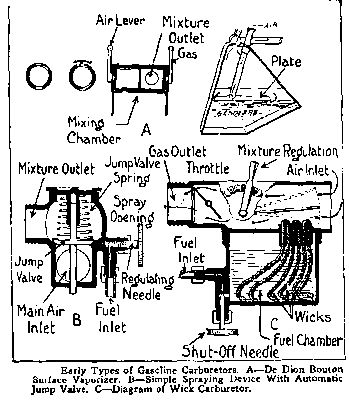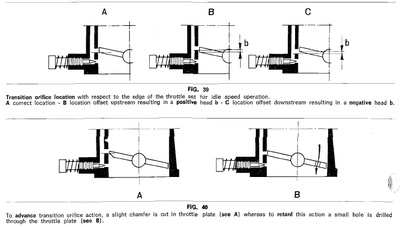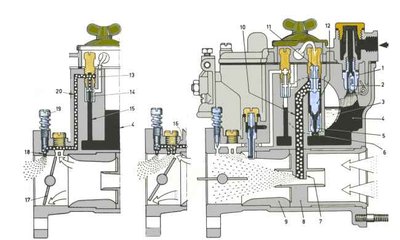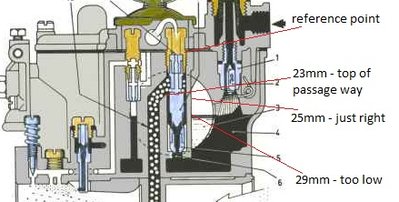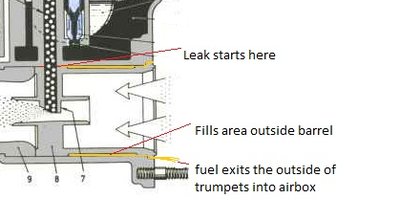HypoJets and O-tubes on the way...
simonknee wrote:If you tune for anything greater than 12.5 on webers then you will get lots of unwanted lean crap.
Thought you might like it if I explain myself here. 12.5 is the (power) ideal and it is the value I am aiming to acheive with all the tweaking. However in the above quote I am talking about the idle mixture. As I mentioned before this is the only thing you have absolute(ish) control over.
Having the AFR meter means I can see what the difference is between different idle mixture settings. At static idle (i.e. stationary) I can adjust the screws evenly to move the idle mixture (normally doing this somewhere in the region of 900rpm). For me there is no discernible difference in idling whether I end up at 12 afr or 14 afr. The difference happens when you drive the car. This idle mix setting has a big influence on the mix under all sorts of part and closed throttle driving. When the idle is 13 and above you get many driving situations where it heads lean up to 16 and beyond! Get the idle to 12.5 and it generally stays under 14-15 whilst driving.
This best idlejets I found for my engine were 45f9, Keith's H223 hypojets have improved control of afr further. However with any idlejet I can confirm (for my SE anyway) that Keith's recommendation to tune the idle to 12.5 is correct. So every time I fiddled with the idlejets or hypojets I try and adjust for 12.5 (it bounces around this value of course).
Simon
Simon
'67 S3 FHC 36/7002
'69 +2 50/1370 (stolen '00)
'67 S3 FHC 36/7002
'69 +2 50/1370 (stolen '00)
-

simonknee - Third Gear

- Posts: 392
- Joined: 18 Sep 2003
... and so, to resolve these minor problems, back in 1908 Fred Lanchester invented fuel injection (copying a design originally proposed by Leonard da Vinci).
http://en.wikipedia.org/wiki/Frederick_W._Lanchester
http://en.wikipedia.org/wiki/Frederick_W._Lanchester
Cheers,
Pete.
http://www.petetaylor.org.uk
LOTUS ELAN flickr GROUP: https://www.flickr.com/groups/2515899@N20
flickr: http://www.flickr.com/photos/16096573@N02/sets/72157624226380576/
https://www.flickr.com/photos/16096573@N02/
Pete.
http://www.petetaylor.org.uk
LOTUS ELAN flickr GROUP: https://www.flickr.com/groups/2515899@N20
flickr: http://www.flickr.com/photos/16096573@N02/sets/72157624226380576/
https://www.flickr.com/photos/16096573@N02/
-

elansprint71 - Coveted Fifth Gear

- Posts: 2636
- Joined: 16 Sep 2003
Simon,
Your data plot appears to show a pretty good tune. Am I correct in assuming the frequency of occurance plots are based upon the green highlighted segments in the time history charts? If this is the case, it shows you have an average idle mixture of about 12.2:1. If one were to filter out this mixture region from the transient chart, which still includes some apparent idle periods, I think the resulting data would show a peak of about a 13:1. Do you agree?
I guess where I'm going is to suggest looking at more defined driving tests and more selectivity in the data one focuses on. I'd want to get rid of any irrelevant data. For example, if you're coasting down from a higher speed, your getting some kind of mixture data that is not very important in the tuning process but is still there to muddy up the water. This may be also be an example of where some of the outlier data comes from. To further reduce unnecessary data, a test plan might be useful. Try to look at:
1. idle
2. slow acceleration over the driving range
3. moderate accleration over the driving range
4. low speed cruise
5. high speed cruise
6. max acceleration, perhaps over different rpm ranges
My personal preference is to pair a lean idle mixture with richer idle jets, to ensure a robust progression and mid range. The lean idle should also help keep the plugs clean. To support a lean idle, one might need a little more ignition advance at idle. Once the throttle plate begins to uncover the progression holes, it gets a richer mixture. If one is using the idle mixture screw gas contribution to support progression, I think the tuning becomes more difficult, but can be useful in richening the low end of progression. As the throttle opens, the idle mixture screw contribution decreases because more progression holes are exposed and manifold vacuum will decreases.
Another thing we haven't touched upon is mixture differences between the cylinders. I assume the data is based upon an average of all four cylinders. Its likely one cylinder will be a little leaner or richer than another. Annoying driveability issues, for instance a light throttle lean miss, can sometimes be limited to one cylinder.
Bill
Your data plot appears to show a pretty good tune. Am I correct in assuming the frequency of occurance plots are based upon the green highlighted segments in the time history charts? If this is the case, it shows you have an average idle mixture of about 12.2:1. If one were to filter out this mixture region from the transient chart, which still includes some apparent idle periods, I think the resulting data would show a peak of about a 13:1. Do you agree?
I guess where I'm going is to suggest looking at more defined driving tests and more selectivity in the data one focuses on. I'd want to get rid of any irrelevant data. For example, if you're coasting down from a higher speed, your getting some kind of mixture data that is not very important in the tuning process but is still there to muddy up the water. This may be also be an example of where some of the outlier data comes from. To further reduce unnecessary data, a test plan might be useful. Try to look at:
1. idle
2. slow acceleration over the driving range
3. moderate accleration over the driving range
4. low speed cruise
5. high speed cruise
6. max acceleration, perhaps over different rpm ranges
My personal preference is to pair a lean idle mixture with richer idle jets, to ensure a robust progression and mid range. The lean idle should also help keep the plugs clean. To support a lean idle, one might need a little more ignition advance at idle. Once the throttle plate begins to uncover the progression holes, it gets a richer mixture. If one is using the idle mixture screw gas contribution to support progression, I think the tuning becomes more difficult, but can be useful in richening the low end of progression. As the throttle opens, the idle mixture screw contribution decreases because more progression holes are exposed and manifold vacuum will decreases.
Another thing we haven't touched upon is mixture differences between the cylinders. I assume the data is based upon an average of all four cylinders. Its likely one cylinder will be a little leaner or richer than another. Annoying driveability issues, for instance a light throttle lean miss, can sometimes be limited to one cylinder.
Bill
- bill308
- Fourth Gear

- Posts: 736
- Joined: 27 May 2004
Hi Bill,
The plots are based on the green highlights but I am zoomed in on the telemetry plots so there is more data included in the afr spread graphs.
I did this highlighting by hand but have found that the LogWorks software includes proper search/filter functionality which will make this more accurate.
e.g. I can filter out idle by specifying NOT((rpm < 1000) AND (tps <10))
About my idle...
I am going down Keith's route when it comes to setting idle. The AFR meter confirms that if I set the idle to, say, 13.5 then just as you open the throttle you get a 18+ lean peak. This is because the progression holes have yet to engage. Too much of this and you get the classic off-idle stumble, even if I don't I want a lean peak just when I actually need power.
So maybe I should encourage the progression jets to engage sooner? Weber docs show the correct position (and Keith describes this too).
Chamfering the butterflies, swapping the butterflies, drilling holes - not shown here but drilling a new first progression hole is another method and Keith is making special tools to do this, in-situ(!), as we type. My butterflies sit around position B when at 800-900rpm.
The top hole is the first progression hole. See the edge of my butterfly sitting too far downstream - oh joy I get to do chamferring. I could set a higher idle but this then prompts the possibility of lazy-idle (the progression jets still supplying fuel at closed-throttle so the engine not settling down to a sub 1000rpm but only slowly dropping).
The idle mix is also very important when you lift-off throttle at speed. It is now the only jet supplying fuel and this can go far too lean. The pops/farts in the exhaust sound cool but it means you are too lean and unburnt fuel is igniting in the exhaust. Also carbs may spit back. Finally you get a stumble as you try to go back on throttle. All bad and all why 12.5 idle mix is good for me!
I do have cylinder differences and I can't measure this with the afr. Would need a bung on exhaust pipe at the manifold! What I do know is that of the four children #2 is a spitter and #4 is the dirty sibling (mustn't ignore the fact that the engine breather contributes to this). As I posted earlier, I will enlarge the hole in #4s butterfly. I may also adjust the jetting on #2 in time.
Right now I am having a pause until I get my exhaust done. Later in the month I will get into the country. Off up the Scotland to get married! I'm sure she's not going to mind me tunig the car as we go
Simon
The plots are based on the green highlights but I am zoomed in on the telemetry plots so there is more data included in the afr spread graphs.
I did this highlighting by hand but have found that the LogWorks software includes proper search/filter functionality which will make this more accurate.
e.g. I can filter out idle by specifying NOT((rpm < 1000) AND (tps <10))
About my idle...
I am going down Keith's route when it comes to setting idle. The AFR meter confirms that if I set the idle to, say, 13.5 then just as you open the throttle you get a 18+ lean peak. This is because the progression holes have yet to engage. Too much of this and you get the classic off-idle stumble, even if I don't I want a lean peak just when I actually need power.
So maybe I should encourage the progression jets to engage sooner? Weber docs show the correct position (and Keith describes this too).
Chamfering the butterflies, swapping the butterflies, drilling holes - not shown here but drilling a new first progression hole is another method and Keith is making special tools to do this, in-situ(!), as we type. My butterflies sit around position B when at 800-900rpm.
The top hole is the first progression hole. See the edge of my butterfly sitting too far downstream - oh joy I get to do chamferring. I could set a higher idle but this then prompts the possibility of lazy-idle (the progression jets still supplying fuel at closed-throttle so the engine not settling down to a sub 1000rpm but only slowly dropping).
The idle mix is also very important when you lift-off throttle at speed. It is now the only jet supplying fuel and this can go far too lean. The pops/farts in the exhaust sound cool but it means you are too lean and unburnt fuel is igniting in the exhaust. Also carbs may spit back. Finally you get a stumble as you try to go back on throttle. All bad and all why 12.5 idle mix is good for me!
I do have cylinder differences and I can't measure this with the afr. Would need a bung on exhaust pipe at the manifold! What I do know is that of the four children #2 is a spitter and #4 is the dirty sibling (mustn't ignore the fact that the engine breather contributes to this). As I posted earlier, I will enlarge the hole in #4s butterfly. I may also adjust the jetting on #2 in time.
Right now I am having a pause until I get my exhaust done. Later in the month I will get into the country. Off up the Scotland to get married! I'm sure she's not going to mind me tunig the car as we go
Simon
Simon
'67 S3 FHC 36/7002
'69 +2 50/1370 (stolen '00)
'67 S3 FHC 36/7002
'69 +2 50/1370 (stolen '00)
-

simonknee - Third Gear

- Posts: 392
- Joined: 18 Sep 2003
An illuminating test to apply to your webers is to increase the idle speed up into the 1000-2000 (or more) range.
Then close off one or more of the idle mixture screws (not too tight please - easy to damage the needle end).
You may be surprised and illuminated at just how long they still contribute to the party.
There is a lot of very useful information in this picture. I have returned to it a lot when understanding what actually happens in a DCOE
Then close off one or more of the idle mixture screws (not too tight please - easy to damage the needle end).
You may be surprised and illuminated at just how long they still contribute to the party.
There is a lot of very useful information in this picture. I have returned to it a lot when understanding what actually happens in a DCOE
Simon
'67 S3 FHC 36/7002
'69 +2 50/1370 (stolen '00)
'67 S3 FHC 36/7002
'69 +2 50/1370 (stolen '00)
-

simonknee - Third Gear

- Posts: 392
- Joined: 18 Sep 2003
bill308 wrote:If one were to filter out this mixture region from the transient chart, which still includes some apparent idle periods, I think the resulting data would show a peak of about a 13:1. Do you agree?
Look again at the telemetry Bill, whilst the tps shows throttle closed (red trace) the rpm shows non-idle (black trace).
These are portions where I am decelerating in gear or braking and hence I included them in my non-idle afr spread.
Like you test list though. Will be doing this as soon as I can.
Simon
'67 S3 FHC 36/7002
'69 +2 50/1370 (stolen '00)
'67 S3 FHC 36/7002
'69 +2 50/1370 (stolen '00)
-

simonknee - Third Gear

- Posts: 392
- Joined: 18 Sep 2003
Chancer wrote:They say a picture is worth a million words well that one certainly is!
Note the fuel level in the body.
This demonstrates (not to scale) the low level that Weber at al recommended over the years
What Keith discovered was the great benefit to run it just below the aux venturi feed passage.
That old 2-3k stumble is caused by the time it takes for for that fuel to get lifted up the extra 4mm or more before it can make it's way to the down the passage and hence to your airflow.
Simon
'67 S3 FHC 36/7002
'69 +2 50/1370 (stolen '00)
'67 S3 FHC 36/7002
'69 +2 50/1370 (stolen '00)
-

simonknee - Third Gear

- Posts: 392
- Joined: 18 Sep 2003
Whilst I'm on a mspaint roll...
If you have fuel in your airbox - or it just smells of fuel after a hard run then...
First thing is to better seal the choke in the barrel. It tends to be a bit slack.
There is info on Keith's forum about doing this.
Then for good measure fashion a gasket to seal the outside of the trumpets when clamped into the airbox.
I use what I know as "green string" http://uk.rs-online.com/web/p/cable-sleeves/0399401/
Works a treat. Might save you from something nasty.
If you have fuel in your airbox - or it just smells of fuel after a hard run then...
First thing is to better seal the choke in the barrel. It tends to be a bit slack.
There is info on Keith's forum about doing this.
Then for good measure fashion a gasket to seal the outside of the trumpets when clamped into the airbox.
I use what I know as "green string" http://uk.rs-online.com/web/p/cable-sleeves/0399401/
Works a treat. Might save you from something nasty.
Simon
'67 S3 FHC 36/7002
'69 +2 50/1370 (stolen '00)
'67 S3 FHC 36/7002
'69 +2 50/1370 (stolen '00)
-

simonknee - Third Gear

- Posts: 392
- Joined: 18 Sep 2003
I used some Viton "O" rings to seal the air horn joint to the carbs. Also used some flat stock rubber, cut into strips to seal the slot in the carbs. Along with my other mods, everything stays nice and dry.
One of these days, I am going to take a close look at the boss on the outer carb throats and see if they can be drilled, threaded and use a grub screw like the 45mm carbs. Though my additional methods of increasing spring tension is still working, after almost 6 years, a grub screw with a locking nut would be more permanent.
Rob Walker
26-4889
One of these days, I am going to take a close look at the boss on the outer carb throats and see if they can be drilled, threaded and use a grub screw like the 45mm carbs. Though my additional methods of increasing spring tension is still working, after almost 6 years, a grub screw with a locking nut would be more permanent.
Rob Walker
26-4889
Rob Walker
26-4889
50-0315N
1964 Sabra GT
1964 Elva Mk4T Coupe (awaiting restoration)
1965 Ford Falcon Ranchero, 302,AOD,9",rack and pinion,disc,etc,etc,etc
1954 Nash Healey LeMans Coupe
Owning a Lotus will get you off the couch
26-4889
50-0315N
1964 Sabra GT
1964 Elva Mk4T Coupe (awaiting restoration)
1965 Ford Falcon Ranchero, 302,AOD,9",rack and pinion,disc,etc,etc,etc
1954 Nash Healey LeMans Coupe
Owning a Lotus will get you off the couch
- prezoom
- Coveted Fifth Gear

- Posts: 1176
- Joined: 16 Mar 2009
Hi Simon,
A very interesting thread. I have the leak comming from the choke tube that you refer to. Could you please point me in the direction of the fix as per your post
Iv'e been looking for hours and cannot find it.
Thanks Mick G
A very interesting thread. I have the leak comming from the choke tube that you refer to. Could you please point me in the direction of the fix as per your post
.First thing is to better seal the choke in the barrel. It tends to be a bit slack.
There is info on Keith's forum about doing this.
Iv'e been looking for hours and cannot find it.
Thanks Mick G
- MickG
- Third Gear

- Posts: 271
- Joined: 14 Jan 2011
Simon,
Yup, "apparent idle periods" was the wrong selection of words. I should have posted "closed throttle periods".
The bigger point in my mind is that mixture data from a closed throttle or even a closing throttle only clouds the tuning picture on the statistical side. It would be interresting to see the AF distribution if all the closed throttle data could were filtered out. I would think a peak occurance at 13:1 would be pretty good for the transient range. I'm not saying it's optimum, only that it's a safe place place to operate.
Bill
Yup, "apparent idle periods" was the wrong selection of words. I should have posted "closed throttle periods".
The bigger point in my mind is that mixture data from a closed throttle or even a closing throttle only clouds the tuning picture on the statistical side. It would be interresting to see the AF distribution if all the closed throttle data could were filtered out. I would think a peak occurance at 13:1 would be pretty good for the transient range. I'm not saying it's optimum, only that it's a safe place place to operate.
Bill
- bill308
- Fourth Gear

- Posts: 736
- Joined: 27 May 2004
Hopefully this evening I can do your set of tests Bill.
It is in an exhaust shop at the moment getting a permanent solution to my leaky y-pipe.
The run back to London gives me scope for various types of driving.
It is in an exhaust shop at the moment getting a permanent solution to my leaky y-pipe.
The run back to London gives me scope for various types of driving.
Simon
'67 S3 FHC 36/7002
'69 +2 50/1370 (stolen '00)
'67 S3 FHC 36/7002
'69 +2 50/1370 (stolen '00)
-

simonknee - Third Gear

- Posts: 392
- Joined: 18 Sep 2003
Total Online:
Users browsing this forum: No registered users and 14 guests

